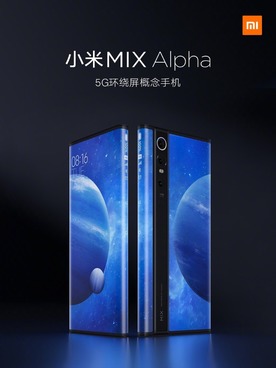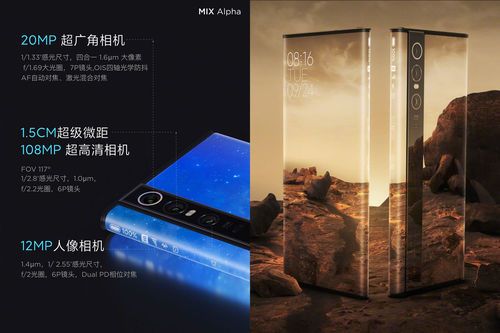Companies have been trying to shrink bezels for the longest time now. Samsung first brought this concept to the mainstream with their Galaxy Note Edge. That phone eliminated the side bezels by curving the screen into the side of the phone. The top and bottom bezels, however, proved to be difficult to eliminate. There are useful tools such as speakers and selfie cameras housed underneath them after all. Other companies followed suit. The NEX S, for example, was the first phone to achieve a nearly bezel-free look by housing the front-facing camera inside mechanized module that pops-up from the body of the phone.
Xiaomi, an ultra-aggressive Chinese manufacturer, is not your ordinary company. They tried this pop-up selfie camera approach too. The well-received Mi 9T is one of the most prominent examples. But they didn’t stop with that. They also tried sliding the selfie-camera instead with their Mix 3. Those two phones were relatively successful in terms of sales. More importantly, they were successful at bringing the bezel ratio down to 85%-90% range. But they weren’t contented.
Thus, the Mi Mix Alpha was born.
It’s an ultra-premium phone that has a 180% screen-to-body ratio. This means that there is more screen than anything else on this phone. How did they do it?
More Screen Than Anything
In a way, they execute this phone similarly to how Samsung does – by bending the screen around the sides. However, Xiaomi takes this further by extending the display a lot further than Samsung ever dared to do.
The result is truly eye-catching. It drew loud gasps from surprised spectators at the recently concluded announcement.
There isn’t much known about the specifics of the screen or how it works yet. But I’m pretty sure that it’s going to be at least a Super AMOLED display. There’s just no point in having that much screen if they’re just going to scrimp on the quality.
One worry about the phone being predominantly made up of a glass display is its durability. The only parts of the phone that isn’t a display is the titanium alloy top and bottom frame, and the ceramic camera strip at the back. Asking if the device is would survive a drop, therefore, is like asking if ice cream would melt if you put it in hot fudge.
Class-Leading Camera
Xiaomi just went all out on this concept smartphone. The display isn’t the only jaw-dropping feature. It also comes packing heat in the camera department.
It’s got a class-leading 108MP main wide-angle camera at the back. That’s unheard of in smartphone territory and rare in the professional camera department as well. Whether the display is going to give justice to that much megapixels is still to be judged once it’s in people’s hands.
What’s surely going to make huge difference in the quality of the images you’re going to take with this camera is the 1/1.33-inch sensor. It’s so much bigger than its competitors. This allows the phone to gather much more light than other smartphones currently out on the market.
Hardware
It’s such a unique phone that it makes having the Snapdragon 855, 12GB RAM, and 512GB of UFS 3.0 storage seem boring.
These are all top-quality specs that isn’t anything to sneer at. It’s an ultra-premium phone after all. With these specs, you’ll be able to do some work and then some.
If this was a normal phone, these specs paired with a 4,050 mAh battery would mean all-day battery life. However, since there is more display to power, this might make the battery life significantly lower than most other smartphones.
Software
It’s so unique that software-wise, it’s going to look quite unfamiliar. It might as well be categorized into another form-factor.
The status icons such as battery and network signal indicators that are usually found at the top of the display is now located at the right edge where your thumbs would naturally rest. There’s also a pressure-sensitive volume button on that same plane.
As for camera software, it looks like you’ll be able to use a normal app as they didn’t do much except improve the sensors themselves.
Since it’s such a unique device, Xiaomi decided to include a couple of A.I.-enabled software features when interacting with the display on the back of the phone. For example, if you’re looking to grab a ride using a ride-hailing service, relevant information will be displayed on it.
Smartphone Concept
It’s Xiaomi’s competitor to the Samsung Galaxy Fold and Huawei Mate X folding phones. Of course, we all know what happened to those two. But Samsung and Huawei never meant to sell billions of those. They’re a proof of concept more than anything else.
The Mi Mix Alpha is the same as those phones. It's a concept smartphone that's built more to test the waters into what future consumers would embrace. As such, it's got the innovator's premium slapped on the price tag. At $2,800, this is not something for the general masses.
Xiaomi, an ultra-aggressive Chinese manufacturer, is not your ordinary company. They tried this pop-up selfie camera approach too. The well-received Mi 9T is one of the most prominent examples. But they didn’t stop with that. They also tried sliding the selfie-camera instead with their Mix 3. Those two phones were relatively successful in terms of sales. More importantly, they were successful at bringing the bezel ratio down to 85%-90% range. But they weren’t contented.
Thus, the Mi Mix Alpha was born.
It’s an ultra-premium phone that has a 180% screen-to-body ratio. This means that there is more screen than anything else on this phone. How did they do it?
More Screen Than Anything
In a way, they execute this phone similarly to how Samsung does – by bending the screen around the sides. However, Xiaomi takes this further by extending the display a lot further than Samsung ever dared to do.
The result is truly eye-catching. It drew loud gasps from surprised spectators at the recently concluded announcement.
There isn’t much known about the specifics of the screen or how it works yet. But I’m pretty sure that it’s going to be at least a Super AMOLED display. There’s just no point in having that much screen if they’re just going to scrimp on the quality.
One worry about the phone being predominantly made up of a glass display is its durability. The only parts of the phone that isn’t a display is the titanium alloy top and bottom frame, and the ceramic camera strip at the back. Asking if the device is would survive a drop, therefore, is like asking if ice cream would melt if you put it in hot fudge.
Class-Leading Camera
Xiaomi just went all out on this concept smartphone. The display isn’t the only jaw-dropping feature. It also comes packing heat in the camera department.
It’s got a class-leading 108MP main wide-angle camera at the back. That’s unheard of in smartphone territory and rare in the professional camera department as well. Whether the display is going to give justice to that much megapixels is still to be judged once it’s in people’s hands.
What’s surely going to make huge difference in the quality of the images you’re going to take with this camera is the 1/1.33-inch sensor. It’s so much bigger than its competitors. This allows the phone to gather much more light than other smartphones currently out on the market.
Hardware
It’s such a unique phone that it makes having the Snapdragon 855, 12GB RAM, and 512GB of UFS 3.0 storage seem boring.
These are all top-quality specs that isn’t anything to sneer at. It’s an ultra-premium phone after all. With these specs, you’ll be able to do some work and then some.
If this was a normal phone, these specs paired with a 4,050 mAh battery would mean all-day battery life. However, since there is more display to power, this might make the battery life significantly lower than most other smartphones.
Software
It’s so unique that software-wise, it’s going to look quite unfamiliar. It might as well be categorized into another form-factor.
The status icons such as battery and network signal indicators that are usually found at the top of the display is now located at the right edge where your thumbs would naturally rest. There’s also a pressure-sensitive volume button on that same plane.
As for camera software, it looks like you’ll be able to use a normal app as they didn’t do much except improve the sensors themselves.
Since it’s such a unique device, Xiaomi decided to include a couple of A.I.-enabled software features when interacting with the display on the back of the phone. For example, if you’re looking to grab a ride using a ride-hailing service, relevant information will be displayed on it.
Smartphone Concept
It’s Xiaomi’s competitor to the Samsung Galaxy Fold and Huawei Mate X folding phones. Of course, we all know what happened to those two. But Samsung and Huawei never meant to sell billions of those. They’re a proof of concept more than anything else.
The Mi Mix Alpha is the same as those phones. It's a concept smartphone that's built more to test the waters into what future consumers would embrace. As such, it's got the innovator's premium slapped on the price tag. At $2,800, this is not something for the general masses.


